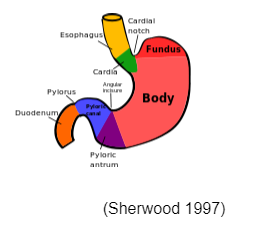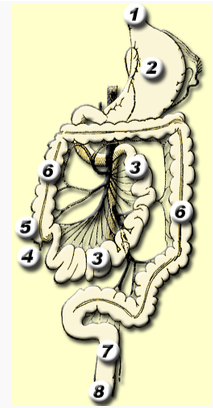The Human Digestive System, Particularly Focusing On Its Two Major Components
Introduction
The digestive system is a human body’s group of organs that works in tandem in digesting food. The process with which the breakdown of food is carried out by the body into the substances in using and absorbing is digestion.
Organs and structure of alimentary canal
The digestive system is divisible in two major groups: accessory digestive organs and alimentary canal. The alimentary canal (gastrointestinal (GI) tract) is the tube’s entire length winding through the human body starting from the mouth and ending in the anus. It provides digestion, absorbing and breaking down the food through the lining of it and in the blood, making it an essential focus for nursing dissertation help.
The alimentary canal consists of the organs including large intestine, small intestine, esophagus, stomach, pharynx, and mouth. There is consideration that alimentary canal is outside the body as at each end (anus, mouth) as it has openings to the external environment.

The accessory digestive organs are inclusive of pancreas, liver, salivary glands, gallbladder, teeth, and tongue. While within the mouth, lie tongue and teeth; the gallbladder and digestive glands lie actually outside of the GI tract and connecting it with the ducts, which are nothing but pathways. The aiding is done by the digestive glands in the food’s mechanical breakdown with the production of many secretion types (Pocock 2006).
The digestion process has six stepsIngestion
The ingestion is the action that takes food in the digestive tract. In other words, eating is ingestion.
Looking for further insights on Child Development and Influencing Factors? Click here.
Propulsion
Propulsion is the manner of the movement of the food throughout the digestive tract. This is inclusive of peristalsis and swallowing. The most important propulsion mean is the peristalsis that has the involvement of relaxation and contraction of muscles which surrounds the organs (mixing of small amount can have occurrence also). There is enormous strength in the peristalsis enabling one to continually digest food even when one has been upside down.
Mechanical breakdown
The mechanical breakdown is inclusive of mixing of food with churning, stomach, tongue, and segmentation that constricts in the small intestine, and chewing. There is increase in the mechanical breakdown with respect to the surface area and thereby increasing absorption. There is mixing food by segmentation with the digestive juices in the small intestine increasing absorption.
Digestion
The food’s chemical breakdown is the digestion. This has the involvement with a series of steps. However, the idea that is most important here is that the secretion of the enzymes into the alimentary canal, which is also called the GI tract, by the gall bladder and the digestive glands aiding in the food molecule’s breakdown.
Absorption
Absorption is the up taking of the digestion’s end products into the lymph or the blood through the GI tract’s wall.
Dig deeper into Human Resource Management at Apple Inc with our selection of articles.
Defecation
Defecation is the elimination of what is indigestible that GI tract does not absorb out of the body through feces and anus (Maton 1993).
The digestive system’s most organs have a part to be taken in more than one of the steps described above. However, there are certain functions that are performed by one organ only. For example, in ingestion, the participation comes from only mouth. And in large intestine, there is occurrence of only defecation.
On the other hand, propulsion takes place within the alimentary canal’s every organ. There is a big role played by the stomach in the digestion of food and the mechanical breakdown. The main absorber is the small intestine, although the stomach and the large intestine also play a role in the absorbing of certain substances. Contrastingly, the esophagus and pharynx also has contribution in propulsion with very little to do with breakdown, absorption, and digestion at all.
Role played by each part in the digestive system’s effective functioning
Digestion: All body parts have the involvement of up taking the food’s digestion along with the undigested material’s elimination constituting the digestive system.
Stage one: Esophagus and Mouth
The first stage of the breakdown in the mouth is action that combines saliva and teeth, chewing and digesting partially the food so as to provide an easy passage along the esophagus. The food’s ball leaving the mouth is termed as a bolus.
Saliva
This is a liquid, which the salivary glands’ three parts secreted: sublingual gland, submandibular gland, and parotid gland.
There are mostly three functions of saliva:
- Lubrication of mucus and food that makes swallowing easier
- Starting of digestion: the acts of the enzyme salivary amylase on cooked starch that turns it in shorter polysaccharides.
- Keeping the teeth and mouth clean (Sherwood 1997).
Tongue
This is a muscular organ that has covering of a membrane.
The functions of tongue are:
Taste: there is covering of the tongue with taste buds whose counts can be of several thousands and being sensitive to bitter, sour, sweet, and salty chemicals in drink and food.
Chewing: The tongue provides aid to chew with the movement of food around the mouth that pushes it between the teeth and cover with saliva. The saliva in contained with enzymes that kick starts the process of digestion.
Swallowing: the readiness of the food to be travelling to the stomach is accompanied by the tongue pushing the food to the back of the mouth.
Esophagus
This is a muscular tube leading from the pharynx to the stomach.
Function: the chewed products are carried to the stomach from the pharynx. The esophagus lining produces the secretion of mucus in lubricating and easing the food passage.
Stage two: Stomach

The functions of stomach are as follows:
- Produces digestion with the enzymes’ action
- Churning of gastric juices and food
- Lubrication of food with the production of mucus
- Absorption of alcohol
- Production of hydrochloric acid that kills food’s bacteria
- Storage of food before it is passed to the small intestine (Kong and Singh 2008).
There is partial digestion of the proteins that takes place at this stage apart from the partial digestion of the carbohydrates, such as starch in the mouth. However, these digestions have to wait till the digestion is complete in the small intestine.
Stage three: Small Intestine
It ensures completion of food’s chemical digestion and the consequent nutrients’ absorption taking place in the small intestine. The absorption of the nutrients takes place through the villi into the lymph and blood vessels (Cummings and Macfarlane 1997). There is virtually no food that is absorbed in any other place in the digestive system.

Lower GI tract - 3) Small intestine; 5) Cecum; 6) Large intestine (Cummings and Macfarlane 1997)

Stage four: Waste and large intestine
The functions include reabsorbing of the nutrients and water from the digestive waste and doing away with the waste. The food that remains is carried out with absorption and conversion in small intestine and stomach with its passage to the large intestine, once the mixing process is over. There is also removal of the remaining nutrients, resulting in feces.
Conclusion
The digestive system is consisting of the accessory digestive organs and alimentary canal. The alimentary canal provides digestion, absorbing and breaking down the food, while the accessory digestive organs are comprised of pancreas, liver, salivary glands, gallbladder, teeth, and tongue. The six steps of digestion are ingestion, propulsion, mechanical breakdown, digestion, absorption, and defecation. The effective functioning of the digestive system is caused in four stages: esophagus and mouth, stomach, small intestine, and waste and large intestine.
Dig deeper into The Evolution of Preaching Styles and Their Role in Worship with our selection of articles.
References:
- Cummings, J. H. and Macfarlane, G. T. (1997) "Role of intestinal bacteria in nutrient metabolism," Journal of parenteral and enteral nutrition, 21 (6): 357–65.
- Kong, F. and Singh, R. P. (2008). "Disintegration of solid foods in human stomach". J. Food Sci., 73 (5): R67–80.
- Maton, A. (1993) Human Biology and Health, Prentice Hall.
- Pocock, G. (2006) Human Physiology (Third ed.), Oxford University Press, p. 382.
- Sherwood, L. (1997) Human physiology: from cells to systems, Belmont, CA: Wadsworth Pub. Co.
- 24/7 Customer Support
- 100% Customer Satisfaction
- No Privacy Violation
- Quick Services
- Subject Experts



